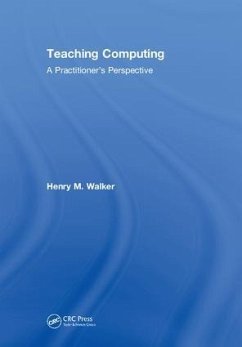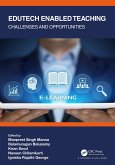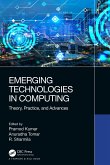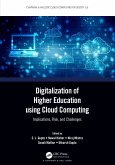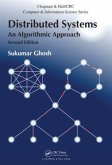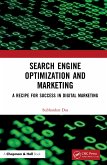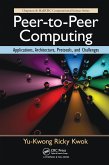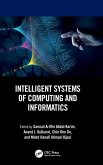- Gebundenes Buch
- Merkliste
- Auf die Merkliste
- Bewerten Bewerten
- Teilen
- Produkt teilen
- Produkterinnerung
- Produkterinnerung
This book provides numerous tips, techniques, and perspectives for both new and experienced computing faculty. Based on the authors' teaching-oriented columns that span 20 years, and informed by computing-education research, the book serves as a resource for college- and university-level teaching practitioners at all experience levels.
Andere Kunden interessierten sich auch für
![Edutech Enabled Teaching Edutech Enabled Teaching]() Edutech Enabled Teaching170,99 €
Edutech Enabled Teaching170,99 €![Emerging Technologies in Computing Emerging Technologies in Computing]() Emerging Technologies in Computing139,99 €
Emerging Technologies in Computing139,99 €![Digitalization of Higher Education Using Cloud Computing Digitalization of Higher Education Using Cloud Computing]() Digitalization of Higher Education Using Cloud Computing170,99 €
Digitalization of Higher Education Using Cloud Computing170,99 €![Distributed Systems Distributed Systems]() Sukumar GhoshDistributed Systems170,99 €
Sukumar GhoshDistributed Systems170,99 €![Search Engine Optimization and Marketing Search Engine Optimization and Marketing]() Subhankar DasSearch Engine Optimization and Marketing147,99 €
Subhankar DasSearch Engine Optimization and Marketing147,99 €![Peer-To-Peer Computing Peer-To-Peer Computing]() Yu-Kwong Ricky KwokPeer-To-Peer Computing120,99 €
Yu-Kwong Ricky KwokPeer-To-Peer Computing120,99 €![Intelligent Systems of Computing and Informatics Intelligent Systems of Computing and Informatics]() Intelligent Systems of Computing and Informatics158,99 €
Intelligent Systems of Computing and Informatics158,99 €-
-
-
This book provides numerous tips, techniques, and perspectives for both new and experienced computing faculty. Based on the authors' teaching-oriented columns that span 20 years, and informed by computing-education research, the book serves as a resource for college- and university-level teaching practitioners at all experience levels.
Hinweis: Dieser Artikel kann nur an eine deutsche Lieferadresse ausgeliefert werden.
Hinweis: Dieser Artikel kann nur an eine deutsche Lieferadresse ausgeliefert werden.
Produktdetails
- Produktdetails
- Verlag: CRC Press
- Seitenzahl: 496
- Erscheinungstermin: 11. April 2018
- Englisch
- Abmessung: 234mm x 156mm x 27mm
- Gewicht: 875g
- ISBN-13: 9781138549784
- ISBN-10: 1138549789
- Artikelnr.: 52530847
- Herstellerkennzeichnung
- Libri GmbH
- Europaallee 1
- 36244 Bad Hersfeld
- gpsr@libri.de
- Verlag: CRC Press
- Seitenzahl: 496
- Erscheinungstermin: 11. April 2018
- Englisch
- Abmessung: 234mm x 156mm x 27mm
- Gewicht: 875g
- ISBN-13: 9781138549784
- ISBN-10: 1138549789
- Artikelnr.: 52530847
- Herstellerkennzeichnung
- Libri GmbH
- Europaallee 1
- 36244 Bad Hersfeld
- gpsr@libri.de
Henry Walker is the Samuel R. and Marie-Louise Rosenthal Professor of Natural Science and Mathematics and Professor of Computer Science at Grinnell College. He was a regular columnist of the SIGCSE Bulletin, and is a current columnist and Associate Editor for ACM Inroads Magazine. He has written over 55 featured columns, and is an ACM Distinguished Educator, former SIGCSE Chair, member of the ACM Retention Committee and the MAA Committee on Departmental Review, and former member of the AP CS A Development Committee of the College Board.
Preface. Introduction. Curricular Development. Developing a useful
curricular model. When is a computing curriulum bloated? Prerequisites:
Shaping the computing curriculum. Using the hill-climbing algorithm with
curricula and courses. Eight principles of an undergraduate curriculum.
Selected References. Courses and the computing curricula in context. An
historical view of computing curricula. Connecting computer science with
other disciplines and the wider community. The role of programming in
introductory computing courses. Motivational Issues. Teaching gifted
students. Selected References. Curricular Issues. Staying connected with
the big picture. Balancing the forest and the trees in courses. Guided
reading and seminar issues. Writing within the computer science curriculum.
College courses of varying credit. CS and Mathematics. Mathematics and CS
topics in the classroom. Mathematics for/with computing and computational
science: an opportunity for reflection and dialog. Beyond the cliche,
mathematical fluency, in the computing curriculum. Why a required course on
theory? Some strategies when teaching theory courses. Lessons from the
CUPM. Selected references (annotated.) Course Formats: Basics, Lab-based,
Active Learning, Flipped Classrooms. Basic do's and don'ts in the
classroom: General environment and course suggestions. Basic do's and
don'ts in the classroom: Combating bias, presentations, and slides. Lab
layouts for individual and collaborative class sessions. A lab-based course
highlighting collaboration. Incorporating active learning within the
classroom. Flipped classrooms. Selected references. Preparing a Course.
Planning and organizing a new course: tips and techniques for getting
started. Course planning: the day-to-day schedule. Reading and class work.
What should be in a syllabus? The role of textbooks. Course development
utilizing student-faculty collaboration. Outreach and Public Relations.
Advertising and recruiting. Computing teaching labs can communicate
negative messages. What image do CS1/CS2 present to our students? Do
computer games have a role in the computing classroom? Resolved: ban
'programming' from introductory computing courses.Course descriptions and
public relations for computer science. In the Classroom. Teacher as Coach,
Mentor, Listener. What teachers should, can, and cannot do? Teaching and a
sense of the dramatic.Teaching and a sense of the dramatic, act II.
Thoughts on student feedback to help teaching.Thoughts on lecturing.
Selected references. Exercises and Assignments. Homework assignments and
internet sources.Finding interesting examples and assignments for CS1.2
assignments.The balance between programming and other assignments. A
racquetball or volleyball simulation. Academic honesty in the classroom.
Exercise solutions: motivations, messages sent, and possible distributions.
Student Progress in Courses. Structuring student work. Encouraging student
preparation for class. Mid-course corrections. Recovering from
disappointing test results. Assessment/Grading. Notes on grading. Grading
and the allocation of points. Selected references. Additional Topics.
Sorting algorithms: when the internet gives out lemons, organize a course
festival. 1000(binary) thoughts for developing and using examples. How to
prepare students for lifelong learning, How to challenge students. Wellness
and the classroom. Selected references
curricular model. When is a computing curriulum bloated? Prerequisites:
Shaping the computing curriculum. Using the hill-climbing algorithm with
curricula and courses. Eight principles of an undergraduate curriculum.
Selected References. Courses and the computing curricula in context. An
historical view of computing curricula. Connecting computer science with
other disciplines and the wider community. The role of programming in
introductory computing courses. Motivational Issues. Teaching gifted
students. Selected References. Curricular Issues. Staying connected with
the big picture. Balancing the forest and the trees in courses. Guided
reading and seminar issues. Writing within the computer science curriculum.
College courses of varying credit. CS and Mathematics. Mathematics and CS
topics in the classroom. Mathematics for/with computing and computational
science: an opportunity for reflection and dialog. Beyond the cliche,
mathematical fluency, in the computing curriculum. Why a required course on
theory? Some strategies when teaching theory courses. Lessons from the
CUPM. Selected references (annotated.) Course Formats: Basics, Lab-based,
Active Learning, Flipped Classrooms. Basic do's and don'ts in the
classroom: General environment and course suggestions. Basic do's and
don'ts in the classroom: Combating bias, presentations, and slides. Lab
layouts for individual and collaborative class sessions. A lab-based course
highlighting collaboration. Incorporating active learning within the
classroom. Flipped classrooms. Selected references. Preparing a Course.
Planning and organizing a new course: tips and techniques for getting
started. Course planning: the day-to-day schedule. Reading and class work.
What should be in a syllabus? The role of textbooks. Course development
utilizing student-faculty collaboration. Outreach and Public Relations.
Advertising and recruiting. Computing teaching labs can communicate
negative messages. What image do CS1/CS2 present to our students? Do
computer games have a role in the computing classroom? Resolved: ban
'programming' from introductory computing courses.Course descriptions and
public relations for computer science. In the Classroom. Teacher as Coach,
Mentor, Listener. What teachers should, can, and cannot do? Teaching and a
sense of the dramatic.Teaching and a sense of the dramatic, act II.
Thoughts on student feedback to help teaching.Thoughts on lecturing.
Selected references. Exercises and Assignments. Homework assignments and
internet sources.Finding interesting examples and assignments for CS1.2
assignments.The balance between programming and other assignments. A
racquetball or volleyball simulation. Academic honesty in the classroom.
Exercise solutions: motivations, messages sent, and possible distributions.
Student Progress in Courses. Structuring student work. Encouraging student
preparation for class. Mid-course corrections. Recovering from
disappointing test results. Assessment/Grading. Notes on grading. Grading
and the allocation of points. Selected references. Additional Topics.
Sorting algorithms: when the internet gives out lemons, organize a course
festival. 1000(binary) thoughts for developing and using examples. How to
prepare students for lifelong learning, How to challenge students. Wellness
and the classroom. Selected references
Preface. Introduction. Curricular Development. Developing a useful
curricular model. When is a computing curriulum bloated? Prerequisites:
Shaping the computing curriculum. Using the hill-climbing algorithm with
curricula and courses. Eight principles of an undergraduate curriculum.
Selected References. Courses and the computing curricula in context. An
historical view of computing curricula. Connecting computer science with
other disciplines and the wider community. The role of programming in
introductory computing courses. Motivational Issues. Teaching gifted
students. Selected References. Curricular Issues. Staying connected with
the big picture. Balancing the forest and the trees in courses. Guided
reading and seminar issues. Writing within the computer science curriculum.
College courses of varying credit. CS and Mathematics. Mathematics and CS
topics in the classroom. Mathematics for/with computing and computational
science: an opportunity for reflection and dialog. Beyond the cliche,
mathematical fluency, in the computing curriculum. Why a required course on
theory? Some strategies when teaching theory courses. Lessons from the
CUPM. Selected references (annotated.) Course Formats: Basics, Lab-based,
Active Learning, Flipped Classrooms. Basic do's and don'ts in the
classroom: General environment and course suggestions. Basic do's and
don'ts in the classroom: Combating bias, presentations, and slides. Lab
layouts for individual and collaborative class sessions. A lab-based course
highlighting collaboration. Incorporating active learning within the
classroom. Flipped classrooms. Selected references. Preparing a Course.
Planning and organizing a new course: tips and techniques for getting
started. Course planning: the day-to-day schedule. Reading and class work.
What should be in a syllabus? The role of textbooks. Course development
utilizing student-faculty collaboration. Outreach and Public Relations.
Advertising and recruiting. Computing teaching labs can communicate
negative messages. What image do CS1/CS2 present to our students? Do
computer games have a role in the computing classroom? Resolved: ban
'programming' from introductory computing courses.Course descriptions and
public relations for computer science. In the Classroom. Teacher as Coach,
Mentor, Listener. What teachers should, can, and cannot do? Teaching and a
sense of the dramatic.Teaching and a sense of the dramatic, act II.
Thoughts on student feedback to help teaching.Thoughts on lecturing.
Selected references. Exercises and Assignments. Homework assignments and
internet sources.Finding interesting examples and assignments for CS1.2
assignments.The balance between programming and other assignments. A
racquetball or volleyball simulation. Academic honesty in the classroom.
Exercise solutions: motivations, messages sent, and possible distributions.
Student Progress in Courses. Structuring student work. Encouraging student
preparation for class. Mid-course corrections. Recovering from
disappointing test results. Assessment/Grading. Notes on grading. Grading
and the allocation of points. Selected references. Additional Topics.
Sorting algorithms: when the internet gives out lemons, organize a course
festival. 1000(binary) thoughts for developing and using examples. How to
prepare students for lifelong learning, How to challenge students. Wellness
and the classroom. Selected references
curricular model. When is a computing curriulum bloated? Prerequisites:
Shaping the computing curriculum. Using the hill-climbing algorithm with
curricula and courses. Eight principles of an undergraduate curriculum.
Selected References. Courses and the computing curricula in context. An
historical view of computing curricula. Connecting computer science with
other disciplines and the wider community. The role of programming in
introductory computing courses. Motivational Issues. Teaching gifted
students. Selected References. Curricular Issues. Staying connected with
the big picture. Balancing the forest and the trees in courses. Guided
reading and seminar issues. Writing within the computer science curriculum.
College courses of varying credit. CS and Mathematics. Mathematics and CS
topics in the classroom. Mathematics for/with computing and computational
science: an opportunity for reflection and dialog. Beyond the cliche,
mathematical fluency, in the computing curriculum. Why a required course on
theory? Some strategies when teaching theory courses. Lessons from the
CUPM. Selected references (annotated.) Course Formats: Basics, Lab-based,
Active Learning, Flipped Classrooms. Basic do's and don'ts in the
classroom: General environment and course suggestions. Basic do's and
don'ts in the classroom: Combating bias, presentations, and slides. Lab
layouts for individual and collaborative class sessions. A lab-based course
highlighting collaboration. Incorporating active learning within the
classroom. Flipped classrooms. Selected references. Preparing a Course.
Planning and organizing a new course: tips and techniques for getting
started. Course planning: the day-to-day schedule. Reading and class work.
What should be in a syllabus? The role of textbooks. Course development
utilizing student-faculty collaboration. Outreach and Public Relations.
Advertising and recruiting. Computing teaching labs can communicate
negative messages. What image do CS1/CS2 present to our students? Do
computer games have a role in the computing classroom? Resolved: ban
'programming' from introductory computing courses.Course descriptions and
public relations for computer science. In the Classroom. Teacher as Coach,
Mentor, Listener. What teachers should, can, and cannot do? Teaching and a
sense of the dramatic.Teaching and a sense of the dramatic, act II.
Thoughts on student feedback to help teaching.Thoughts on lecturing.
Selected references. Exercises and Assignments. Homework assignments and
internet sources.Finding interesting examples and assignments for CS1.2
assignments.The balance between programming and other assignments. A
racquetball or volleyball simulation. Academic honesty in the classroom.
Exercise solutions: motivations, messages sent, and possible distributions.
Student Progress in Courses. Structuring student work. Encouraging student
preparation for class. Mid-course corrections. Recovering from
disappointing test results. Assessment/Grading. Notes on grading. Grading
and the allocation of points. Selected references. Additional Topics.
Sorting algorithms: when the internet gives out lemons, organize a course
festival. 1000(binary) thoughts for developing and using examples. How to
prepare students for lifelong learning, How to challenge students. Wellness
and the classroom. Selected references

